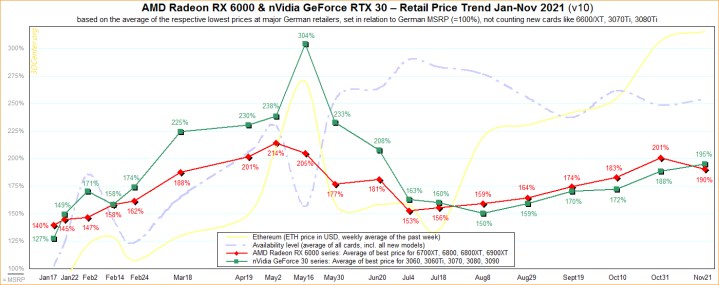A report examining the price trends in the GPU market shows there is little sign of improvement, with some graphics cards now reaching nearly double their retail cost.
According to the latest survey by 3DCenter, while there’s been a slight decrease in prices during the past few weeks for certain AMD graphics cards, the cost for the majority of cards have increased once again. AMD’s RDNA 2 GPUs are now 90% over the manufacturer’s suggested retail price (MSRP), with Nvidia’s Ampere-based lineup hitting 95% over MSRP.

From October 10 until October 31, the average price for the AMD Radeon RX 6000 series trended upwards from 183% of MSRP to 201%. During the course of this month until November 21, it dropped to 190%. It marks the first reduction in prices for the 6700XT, 6800, 6800XT, and 6900XT GPUs since July. Still, the fact remains that the MSRP has nearly doubled for those cards due to depleted stock amounts.
The average price for Nvidia’s GeForce 30 series, meanwhile, has hit its highest point since the start of July. The cost for the 3060, 3060 Ti, 3070, 3080, and 3090 GPUs increased from 188% of MSRP in October to 195% MSRP thus far in November. Although these video cards are still considerably expensive, those price points are a far cry from May 2021, when it cost 304% of MSRP.
Availability levels for both AMD and Nvidia GPUs remain unchanged compared to October. The 3DCenter report is based on the German market, but a quick look at third-party marketplaces like eBay shows how price hikes are also widespread in other key markets such as the U.S. and UK.

Aside from both supply issues and intense demand affecting the current market, an inevitable factor behind the surge in prices for GPUs can be attributed to cryptocurrency. Miners have joined scalpers in contributing to such cost increases due to the recent resurgence in the crypto space. It’s not just gamers who rely on graphics cards; miners can also utilize the power of GPUs for cryptomining purposes.
With this in mind, 3DCenter has added a new feature into its charts that highlights price levels of Ethereum. Unsurprisingly, the coin’s performance corresponds to the increase in prices for GPUs.
Moving forward, don’t expect prices to normalize until 2023 at the earliest. Nvidia believes the current GPU shortage will continue throughout 2022, while Intel says that a supply-demand balance won’t materialize until 2023. The only silver lining for consumers in the meantime are cards like Intel’s rumored sub-$200 Arc Alchemist GPU. Even then, scalpers will in all probability target that product as well.
Editors' Recommendations
- Intel Battlemage graphics cards: release date speculation, price, specs, and more
- Nvidia RTX 50-series graphics cards: news, release date, price, and more
- The sad reality of AMD’s next-gen GPUs comes into view
- You shouldn’t buy these Nvidia GPUs right now
- 5 GPUs you should buy instead of the RTX 4070





